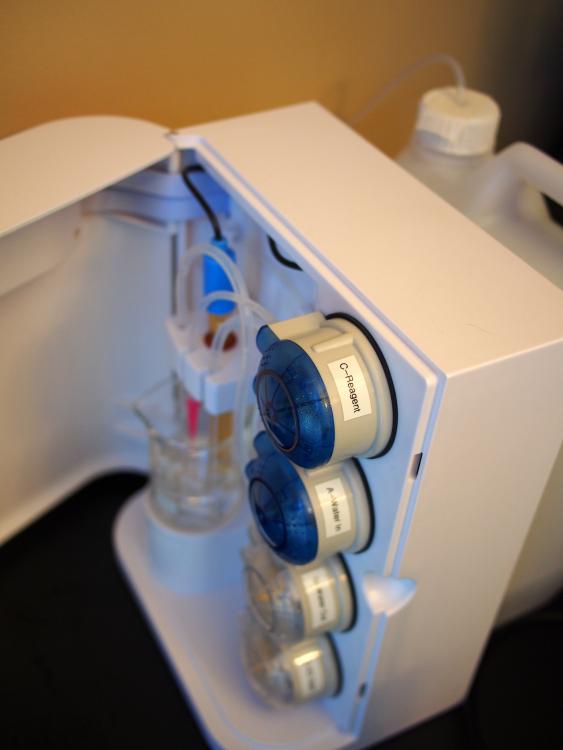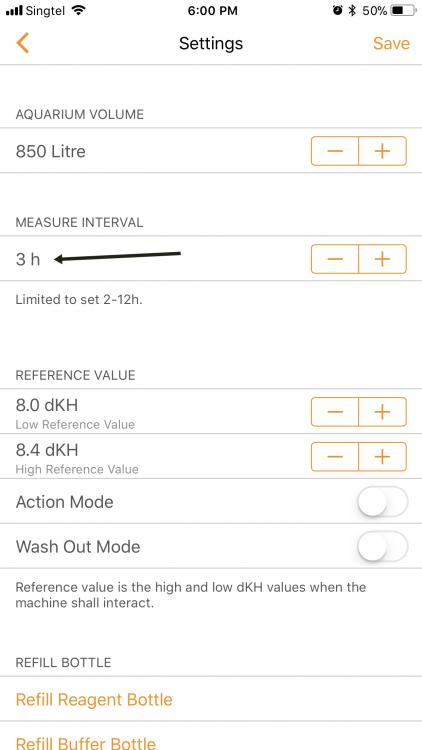-
Posts
2,331 -
Joined
-
Last visited
-
Days Won
119
Content Type
Profiles
Forums
Gallery
Everything posted by SubzeroLT
-
2 reagents are available. 1) 1L Ready to use type 2) 4L concentrated version - I got this The 4L version needs to be mixed with RODI water in a 1:4 ratio. In my case, i mixed 200ml Reagent (1 part) with 800ml RODI water (4 parts). Final amount prepared is 1L. The 4L concentrate can make a total of 20L of reagent. From Alkatronic website, this is sufficient for 2500 tests. That means, if you test every 4 hours (6 tests a day), the reagent will last 1 year. Super economical! Used a digital weighing scale & a 5L container (previously used for ATO water) As the mixture needs to be very accurate, once close to the 200g reagent mark, I used a syringe to drip in the reagent to reach exactly 200g. Then add 800g of water to make it 1000g For those who prefer convenience & dislike mixing stuff, the 1L ready to use reagent is another option.
-
Setting up the Alkatronic is not too difficult. In brief, 1) Hook up the tubes to the side of the unit. (a) Reagent In - This is the reagent that's added bit by bit to measure KH value. Use your own container depending on how often you plan to test. Size it accordingly. In my case, I made 1L of reagent (which will last about 100 tests). More on mixing reagent later. The reagent bottle needs to be placed close to the Alkatronic unit for better accuracy (as shorter tubes means less deviation of fluid flowing through the tubes of the peristaltic pumps. . (b) Water in = Water from your tank. A pre-filter is provided for the tube inlet I placed the inlet in the sump. (3) Water out = Linked to your own waste container. After each test, the solution is expelled from the test beaker. (4) Alk In / Alk Out = I'm not using this at the moment as i'm just monitoring KH this week. But this is to enable very accurate KH dosing measurement to keep values very stable. After all the tubes are hooked up, download the app on your mobile phone. From the app, prime the tubes then calibrate the pumps/pH probe 2) Calibrate pumps. Pump A = Water In Pump C = Reagent In Pump D = KH solution - There are 4 peristaltic pumps in the unit. 3 of them needs to be calibrated (except waste out). Pump calibration is straight forward. The app will trigger a certain amount of water to be pumped out into the provided cyliner. Read & enter the amount of water collected back to the app. 3) Calibrate pH probe - As per standard pH probe calibration process. Uses pH 4 / 7 reference solution. 3) Configure App - Entire aquarium volume. This is to enable pre-calculated auto KH dosing amount - Interval - Ranges from 2-12hrs. The recommended interval is 4 hours. It is possible to manual trigger a measurement. - Enter KH trigger limits. I set a 8.0-8.4 for a start. Plan to narrow the trigger range once it stabilizes. You can set how much reagent was prepared. So the app will notify you when its going to finish.
-
Plan to replicate the same design as my current one. But just make it much taller to take advantage of the wasted space to the top of cabinet. That means, about double the original size. Hope this pic helps
-
Using & exploring it extensively now. Yeah...will share something this weekend. I typically leave it in there for a month. I've ever used too much carbon & noticed coral colors become dull (losing green base on some corals). I suspect excessive carbon was used which adsorbed too much of some elements (possibly iron?). So i would monitor the corals & generally leave the carbon in the sump. But take it out if something odd is happening. I've had the Tisbe pods since Sept 17. They survive with fish food & algae/diatoms but do better when live phyto is added. The rotifer culture needs to be fed twice a day with nannochloropsis Got it in USA through a friend. I recall its ~US$45 for a 800cc pack shipped to USA address. Not cheap at all.
-
This ATS from you is probably one of the best addition for the tank Yeah... hopefully its more durable now. On the to-do list is to make a larger ATS based on this design.
-
Agree. Use a credit card first. Calcium deposits are quite hard. Another option is to use a good magnet glass cleaner with a metal blade. I try not to use blades with hands directly as there could be uneven/excessive pressure -> risk of scratching the glass. Using the blade mounted on a magnet cleaner ensures 'even & just sufficient pressure' (eg. DD Ocean or Tunze are brands i've used)
-
I have too. $10. Bt Batok area Sent from my iPhone using Tapatalk
-
Setting up the Alkatronic this weekend. Small investment for that much needed peace of mind when travelling. Folks in the SRC chat group asked for a review, so i'll just share more updates here. It works as a standalone device or connected to any aquarium controllers. You do this by connecting the BNC out connector from the Alkatronic to the Apex controller (PH probe input). It makes the Apex think its reading a pH probe but its actually your KH reading instead. This means i'm still able to use my Apex Neptune Classic Still in progress of setting it up. Saw that it comes with a tiny stir bar. The stir bar goes into the glass beaker. That's a magnetic stirrer beneath it.
-
Made a new LED light for the ATS as previous ones got wet from water splashing & shorted out. This time it is fully sealed on the 'wet' side. And have heat sinks to help with cooling. Ensured some gap for heat to escape Got these "Algae Cutter" pad (from ReefMarketSG). They worked very well for for scrubbing algae from my acrylic tank since metal blades cannot be used on acrylic. They worked well on glass too. This is what the mesh looks like under the microscope. Interesting to see the nylon strips/fiber construction. No wonder they can scrape off the algae quite well
-
Culturing rotifer, tisbe & other free swimming pods to feed the tank. Tisbe are great as they are bottom dwelling pods. A quick video of the mandarins & scooter blenny. Its nice that the red scooter & blue mandarin dragonet are eating pellets. Spotted mandarins exclusively on pods for now. The video also shows the blue mandarin dragonet attacked by a red tip hermit crab
-
Muchas gracias. Yes, i'm using diving grade soda lime and don't notice an increase in potassium. I still dose potassium regularly at roughly the same amounts. In an attempt to increase pH, i'm doing the following : 1) Soda lime for skimmer air intake 2) Dosing kalk at night (auto dosing with the apex) 3) ATS lighting hours mostly at night 4) Air pump at night (though i don't think it does very much) My AI lights configuration can be found here : http://www.aquaillumination.com/file/signature/ai-signature-leonTan.aip
-
Still can grow bigger
-
Looks like a very thought of design. Some interesting concepts there. Look forward to more pics!
-
Best glass cleaner. Half palm size.
-
Beefing up the joints of the aluminum profile side table with block nuts & joint plates in prep for a small connected tank. This stand straddles over the compressor & partially hides it from view. 'Open' concept stand to maximize air flow. Current Zoa tank converted to house new fishes to acclimatize to eating pellets. Hungry fish on the right doing a great job grazing on the algae on the glass - its so clean compared to the left side.
-
It came as a set from Madpetz' ZERO RODI system. Think they sell it separately.
-
I'm running Hydras on my tank. IMO, its always better to be dimmer than too bright. Generally, UV, V, G, R, CW can be lowered by about 40-50% from your current levels. You can keep the RY & B in the 80% range - to allow the colors to pop. I would keep the lighting hours short too. Maybe ramp up/down 1hr each. Strong lighting hours around 5-6hrs for a start. The tell tale signs of insufficient light for zoa is their neck will stretch out very long. Hammers & Duncans can do very well in extremely low & shaded light.
-
Got mine about 3 years ago. Best to just call them to check stock & current price.
-
Thanks Aqua Illumination for featuring my tank in a magazine ad. There are many other nice tanks featured in the Signature Series. Their profiles can be to download as well. http://www.aquaillumination.com/signature/
-
General maintenance weekend. Change water & dripping in new water for the baby banggai cardinals. Only 10 out of the original 15 fries survived to date Added leak detectors around the calcium reactor. That's where the bag of carbon is placed.
-
Careless of me to use cheap/soft tubing for the phosban reactor. It kinked & blocked water flow into the reactor that contained the rowaphos Phosphate rose increased to ~ 0.2ppm ( =69 ppb phosphorous) Got the tubing reliability resolved. Using thicker Eheim tubing now. Phosphate drop to ideal levels within a couple of days (~ 0.04ppm phosphate = 14ppb phosphorous) Some folks stress over high phosphate levels. In my opinion, phosphate is relatively easy to manage with a good phosphate binder in a reactor. All settled within a week. Once within range, slightly reduce the flow through the reactor to 'maintain' the right levels. I'm using this.
-
Yes. I'm using a pump previously purchased from madeptz. A booster pump makes a huge difference. I'm getting 1.2 parts clean water to 1 part waste water. See video below. Tube with green cable tie is clean water. The other tube is waste water. Using 200gpd membrane & 300gpd flow restrictor. Waste water is collected & re-used for laundry or mopping floor.
-
RO membrane works by passing some water though the membrane (becomes clean water). And leaving some that does NOT pass through the membrane as waste water that flushes out. Having a booster pump will increase the amount of water passing through the membrane - hence improving good/waste water ratio. Sent from my iPhone using Tapatalk
-
This is a very good article about activated carbon : https://joejaworski.wordpress.com/2008/05/09/does-a-reef-tank-need-carbon/ Some notes : Activated carbon works by adsoption (i.e. adhere to the surface). Not absorption. Google for clarity. Fluidizing carbon in a reactor will generate fine dust that'll end up in the tank. I think that tumbling may dislodge stuff adhered to the surface of the carbon (adsorption). Personally i prefer to use use a small mesh bag. Tried a couple of brands so far. DD Rowa Carbon (mentioned in the article as 'excellent) seems to work best for me Place the mesh bag in a high flow area in the sump. Replace every 2 weeks Rowa Carbon Tie it up & rinse in a small amount of RODI water (not tap water). Not much dust is generated. 2-3 rinse is sufficient
-
Got this nice piece from reefer Dez. Super tiny royal blue milli frag. Sea Plume (photosynthetic) This non-photosynthetic gorgonian is still doing OK. Coco worm Rescaped the tank today & moved some clams onto the upper rocks (instead of sand bed) in an attempt to provide more light for the crocea clams.


.thumb.jpg.57c2e34da3fe90fcdb8e11c6a93f46a9.jpg)
.thumb.jpg.34b4e10265d4e0548887723c77eab898.jpg)
.thumb.jpg.b616559d718aedaf8148797b713796ae.jpg)
.thumb.jpg.cb51de3c2316b8540b05b1e9d268efd2.jpg)
.thumb.jpg.24e814b756e404789e6d9a09ced7af4d.jpg)
.thumb.jpg.9773f623e582c7014bc9ea2f460ec154.jpg)

.thumb.jpg.10b986998ae38a5639285d8cc86be610.jpg)
.thumb.jpg.a07fcc7e7509db9d63acb7552eb49d6b.jpg)
.thumb.jpg.81bf9fde91b8ac284372aa6f1fe00a5a.jpg)
.thumb.jpg.62caf1e26621466fa7bbe1f8438a3888.jpg)

.thumb.jpg.8f6f5a6470c1d18cb02914fdf9a426aa.jpg)
.thumb.jpg.395f0d61f2e1bfa060d56d4c4be07864.jpg)
(2).thumb.jpg.c231e3b0e60364d74084499ae9650b0e.jpg)
.thumb.jpg.bd23e935d53c6ef5100b2f4471cacb91.jpg)

.thumb.jpg.46178873e2790d05469f30ec41d0386e.jpg)
.thumb.jpg.afe1550ade4ed96274eba84bd1459018.jpg)
.thumb.jpg.4425df59e97f979fbd7c0d363bf0a6e9.jpg)
.thumb.jpg.94dc908865f7f9ab3da657855d171655.jpg)
.thumb.jpg.eefe25c10a8d002c8257279aeb32b297.jpg)
.thumb.jpg.70ba918d1ec00e99f910f4413f1eb8cf.jpg)
.thumb.jpg.32ad50827b39b3db9f5a98ab09193d85.jpg)
.thumb.jpg.ea73979ad32d2c10a605a3af1ae547b7.jpg)
.thumb.jpg.937eb0224a3f522ad30b62164aa0f73c.jpg)
.thumb.jpg.792b38cde196666bddf5ac1452e06004.jpg)
.thumb.jpg.d5e3eb7688ee747111a05d8b9c9260a3.jpg)
.thumb.jpg.192e30a85993931e43282c54fa66bfbf.jpg)
.thumb.jpeg.cd9e0ea72731b40d25000dab80e91f01.jpeg)
.thumb.jpg.40c3b60a0b4826abc12809ef5247e13e.jpg)
.thumb.jpg.b84ad93144a4b16f7b88fe6737ed76ef.jpg)
.thumb.jpg.c9c9358c50b1146c1374b19b3f9756c4.jpg)
.thumb.jpg.df1addd7d40b6c0116702d93ab000420.jpg)
.thumb.jpg.4e146d2c9d877e09c0fa2fe1173563b9.jpg)
.thumb.jpg.ccfdb32121d0cc75f8215dbdf0e07795.jpg)
.thumb.jpg.f5dd1625dfeb2fa8426753242c3a0527.jpg)
.thumb.jpg.7a3103acb14c4fa89cef94f107a18e9c.jpg)
.thumb.jpg.16e051ebd4ee4563429bcc02b7dc7e16.jpg)
.thumb.jpg.278f76fe06b8d4377c7f94bee93cef1d.jpg)
.thumb.jpg.b7d68bd86b5151d0ee2c80e25d52bcd3.jpg)
.thumb.jpg.5fc23e9a6eb0345a8af835f46dd91304.jpg)
.thumb.jpg.1f17c37f7191ecf4b1b00a30c2abb57b.jpg)
.thumb.jpg.b987b692bf51481b5be6eb04ee4b9962.jpg)
.thumb.jpg.9db23463add2d65a0a40b82fc552b1e3.jpg)
.thumb.jpg.966e66aa93b72612173c8cbf594ecd89.jpg)